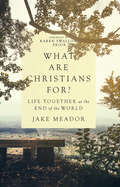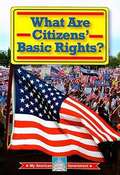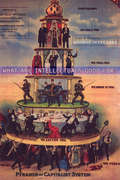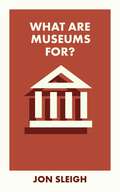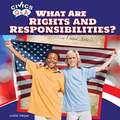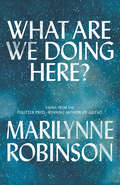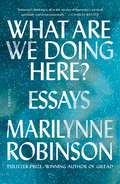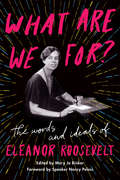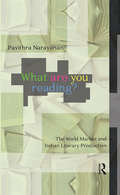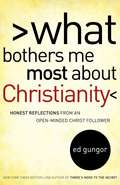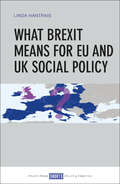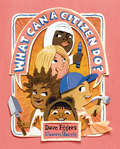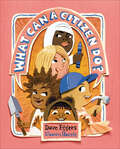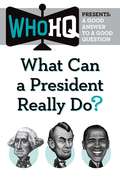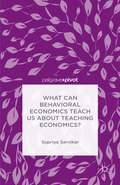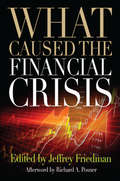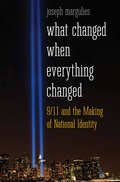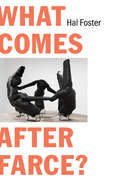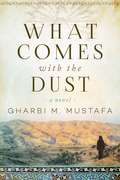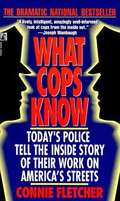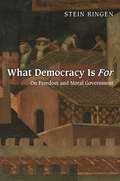- Table View
- List View
What Are Christians For?: Life Together at the End of the World
by Jake MeadorWhat does a Christian political witness look like in our day? Politics ought to be defined by fidelity to the common good of all the members of society. But our modern Western politics are defined by a determination to bend the natural world and human life to its own political and economic ends. This wholesale rejection of the natural order is behind the dominant revolutions in our history, and defines our experience in Western society today���our racialized hierarchy, modern industry, and the sexual revolution. In What Are Christians For?, Jake Meador lays out a proposal for a Christian politics rooted in the givenness and goodness of the created world. He is uninterested in the cultural wars that have so often characterized American Christianity. Instead, he casts a vision for an ordered society that rejects the late modern revolution at every turn and is rooted in the natural law tradition and the great Protestant confessions. Here is a political approach that is antiracist, anticapitalist, and profoundly pro-life. A truly Christian political witness, Meador argues, must attend closely to the natural world and renounce the metallic fantasies that have poisoned common life in America life for too long.
What Are Citizens' Basic Rights? (My American Government)
by William David ThomasDescribes the civil rights guaranteed in the Constitution, especially the Bill of Rights, and discusses First Amendment rights, the rights of the accused, and the responsibilities of citizenship.
What Are Intellectuals Good For?: Essays & Reviews
by George ScialabbaEssays and reviews concentrating on politics, economics, sociology and culture. When George’s What Are Intellectuals Good For? appeared it was greeted by an NPR review that sang the book’s praises. Pressed Wafer was totally unprepared for the blizzard of orders that came from Amazon. We hustled out and purchased the George Scialabba Two Wheeler to cart the books to the Post Office! The current cliché is that America has no public intellectuals. Every sentence George writes gives the lie to this bit of lazy journalese.
What Are Museums For? (What Is It For?)
by Jon SleighThe days when museums were dusty, stuffy institutions displaying their wealth and wisdom to a reverential public are over. Museums today are a cultural battleground. Who should decide what is put on display and how it is presented? Who gets to set the narrative? In this passionately argued book, Jon Sleigh maintains that museums must be for all people and inclusion must be at the heart of everything they do. But what does good inclusion look like in practice? Cleverly structured like a museum tour, Sleigh uses seven illustrative museum objects from seven very different museums to explore such wide-ranging issues as trust-building, representation, digital access, conflicting narratives, removal from display and restitution.
What Are Rights And Responsibilities? (Civics Q&A Series)
by Leslie HarperReaders will learn about a citizens rights and responsibilities through engaging, accessible text. After reading, they will be able define the difference between a right and a responsibility, gives examples of rights people have stood up and fought for, and of responsibilities that are part of good citizenship. Readers will gain a new understanding of the importance of the relationship between citizenship and society.
What Are We Doing Here?
by Marilynne RobinsonNew essays on theological, political, and contemporary themes, by the Pulitzer Prize winner.Marilynne Robinson has plumbed the human spirit in her renowned novels, including Lila, winner of the National Book Critics Circle Award, and Gilead, winner of the Pulitzer Prize and the National Book Critics Circle Award. In this new essay collection she trains her incisive mind on our modern political climate and the mysteries of faith. Whether she is investigating how the work of great thinkers about America like Emerson and Tocqueville inform our political consciousness or discussing the way that beauty informs and disciplines daily life, Robinson's peerless prose and boundless humanity are on full display. What Are We Doing Here? is a call for Americans to continue the tradition of those great thinkers and to remake political and cultural life as "deeply impressed by obligation [and as] a great theater of heroic generosity, which, despite all, is sometimes palpable still."
What Are We Doing Here?: Essays
by Marilynne RobinsonNew essays on theological, political, and contemporary themes, by the Pulitzer Prize winnerMarilynne Robinson has plumbed the human spirit in her renowned novels, including Lila, winner of the National Book Critics Circle Award, and Gilead, winner of the Pulitzer Prize and the National Book Critics Circle Award. In this new essay collection she trains her incisive mind on our modern political climate and the mysteries of faith. Whether she is investigating how the work of great thinkers about America like Emerson and Tocqueville inform our political consciousness or discussing the way that beauty informs and disciplines daily life, Robinson’s peerless prose and boundless humanity are on full display. What Are We Doing Here? is a call for Americans to continue the tradition of those great thinkers and to remake American political and cultural life as “deeply impressed by obligation [and as] a great theater of heroic generosity, which, despite all, is sometimes palpable still.”
What Are We Doing Here?: Essays
by Marilynne RobinsonNew essays on theological, political, and contemporary themes, by the Pulitzer Prize winner.Marilynne Robinson has plumbed the human spirit in her renowned novels, including Lila, winner of the National Book Critics Circle Award, and Gilead, winner of the Pulitzer Prize and the National Book Critics Circle Award. In this new essay collection she trains her incisive mind on our modern political climate and the mysteries of faith. Whether she is investigating how the work of great thinkers about America like Emerson and Tocqueville inform our political consciousness or discussing the way that beauty informs and disciplines daily life, Robinson's peerless prose and boundless humanity are on full display. What Are We Doing Here? is a call for Americans to continue the tradition of those great thinkers and to remake political and cultural life as "deeply impressed by obligation [and as] a great theater of heroic generosity, which, despite all, is sometimes palpable still."
What Are We For?: The Words and Ideals of Eleanor Roosevelt
by Eleanor RooseveltFrom one of the world’s most celebrated and admired public figures, Eleanor Roosevelt, a collection of her most treasured sayings—the perfect gift for Mother’s Day, graduation, and a new generation of feminists.With a foreword by Speaker Nancy PelosiNo one can make you feel inferior without your consent. We’ve all heard this powerful Eleanor Roosevelt adage—it is, perhaps, one of her best known. A wise leader, she knew the power of words, and throughout her work as First Lady, a UN representative, and advocate for human rights, women, youth, minorities, and workers, she was a prolific writer and speaker. Eleanor’s wise words on government, race and ethnicity, freedom, democracy, economics, women and gender, faith, children, war, peace, and our everyday lives leap off the page in memorable quotations such as:· One's philosophy is not best expressed in words; it is expressed in the choices one makes.· Progress is rarely achieved by indifference.· I am convinced that every effort must be made in childhood to teach the young to use their own minds. For one thing is sure: If they don’t make up their minds, someone will do it for them. · Unless people are willing to face the unfamiliar they cannot be creative in any sense, for creativity always means the doing of the unfamiliar, the breaking of new ground.…and these are just a few. At this politically and culturally divided moment in our nation’s history, Eleanor Roosevelt’s quotes have an even deeper resonance—as moving and insightful as they are timely. What Are We For? is a celebration of a cultural icon, and a powerful reminder of Eleanor Roosevelt’s extraordinary contributions to our country, and the world.
What are you Reading?: The World Market and Indian Literary Production
by Pavithra NarayananThis book offers a material critique on various aspects of Indian literary production and its reception by its audiences. Taking a historical and contemporary lineage into account, the author variously discusses the social, political, and economic factors that impact upon and determine choices in the publishing world. Examining the constructions of the archive of postcolonial works by Indian writers in relation to nationalist histories, language wars, and the relationship between economic policies and literature, the book forcefully argues that why we read what we read is more than coincidental. Placing the rights of minoritized and disadvantaged communities at the heart of the analysis of India’s decolonization and industrial projects, the book attempts to address not just inequalities in the publishing world, but also social inequities engendered by global capitalism. Offering a critique of academics who act as cultural gatekeepers of intellectual production, the book finally underscores the disconnect between the academic theory and practice of scholars of postcolonial studies who argue against inequality and marginalization while simultaneously supporting hegemonic academic practices. This book will be of interest to scholars of development studies, cultural studies, literature, postcolonial studies, economics, and those studying globalization, as well as the interested lay reader.
What Bothers Me Most about Christianity
by Ed GungorA Provocative Discussion on the Messiness of Faith It may seem odd that an avowed Christ follower would write a whole book on the bothersome aspects of Christianity. But if we're honest, we can't ignore the fact that some things about Christianity are just plain messy. Without fear or hesitation, Ed Gungor joins the discussion generated by the multitude of atheistic books, as he explores the most difficult aspects of the Christian faith, including... Why doesn't God just show Himself? Why does a loving God allow evil in His world? If the Christian faith is so good, why are some Christians so bad? Why was God so harsh during Old Testament times? Why is the Christian faith so exclusive? Maintaining that faith is not intellectual suicide and that mystery is an essential quality of the Christian belief, Gungor speaks with reason, candor, and a touch of humor to thinking people on both sides of the debate.ussion between thinking people on both sides of the debate, from aggressive atheists to unswerving Christian believers. Gungor maintains that balancing faith and reason is indeed possible and that devoted Christ followers need not shy away from asking the tough questions. As he guides readers through these fundamental issues, they will find that their honest wrestling will actually bring them to a deeper, more mature understanding of faith.
What Brexit Means for EU and UK Social Policy
by Linda HantraisDrawing on a range of disciplinary, conceptual and theoretical approaches, this book analyses the complex interconnections between social policy formation and implementation in the European Union before and during the UK’s membership. It explores the issues, debates and policy challenges facing the EU at different stages in its development, and shows how the UK promoted and hampered social integration. With the UK’s decision to leave the EU as one of the greatest challenges in the EU’s history, this book seeks to understand the role played by social policy in the referendum campaign and withdrawal negotiations, and considers what Brexit means for social policy development both in the UK and across the EU.
What Can a Citizen Do?
by Dave Eggers Shawn HarrisA citizen can pick up litterA citizen can pull a weedA citizen can help that critterA citizen can plant a seedA citizen can aid a neighbor A citizen can join a causeA citizen can write a letterA citizen can help change laws . . .Empowering and timeless, What Can a Citizen Do? is the latest collaboration from the acclaimed duo behind the bestselling Her Right Foot: Dave Eggers and Shawn Harris. This is a book for today's youth about what it means to be a citizen.Across the course of several seemingly unrelated but ultimately connected actions by different children, we watch how kids turn a lonely island into a community—and watch a journey from what the world should be to what the world could be.This is a book about what citizenship—good citizenship—means to you, and to us all.
What Can a Citizen Do?
by Dave Eggers Shawn Harris&“[This] charming book provides examples and sends the message that citizens aren&’t born but are made.&” —The Washington Post This is a book about what citizenship—good citizenship—means: Across the course of several seemingly unrelated but ultimately connected actions by different children, we watch how kids turn a lonely island into a community—and watch a journey to what the world could be. With beautiful illustrations and rhyming text, What Can a Citizen Do? is the latest collaboration from the team behind Her Right Foot: New York Times–bestselling author Dave Eggers and acclaimed artist Shawn Harris. It&’s a delightfully engaging way for young readers to be inspired about the meaning of citizenship and the positive role they can play in our country and our world. &“Obligatory reading for future informed citizens.&” —The New York Times &“An absolute delight.&” —Maile Meloy, New York Times–bestselling author of Do Not Become Alarmed &“[A] must-have book.&” —School Library Journal
What Can a President Really Do?: A Good Answer to a Good Question
by Who HqDirect from Who HQ, the team that brings you the New York Times Best-Selling Who Was? biography series, comes Who HQ Presents. These short illustrated e-Books provide quick, simple answers to the important questions being asked today about politics, social issues, the environment, and more!How much power does a US president really have? Wonder no more: Who HQ Presents the answers to what presidents can do on their own, how the three branches of government hold one another in check, and what executive orders presidents have signed in the past.
What Can Behavioral Economics Teach Us about Teaching Economics?
by Supriya SarnikarSarnikar cites evidence of frequent misconceptions of economics amongst students, graduates, and even some economists, and argues that behavioral economists are uniquely qualified to investigate causes of poor learning in economics. She conducts a review of the economics education literature to identify gaps in current research efforts and suggests a two-pronged approach to fill the gaps: an engineering approach to the adoption of innovative teaching methods and a new research program to enhance economists' understanding of how learning occurs. To facilitate research into learning processes, Sarnikar provides an overview of selected learning theories from psychology, as well as new data on hidden misconceptions amongst beginning students of economics. She argues that if they ask the right questions, economists of all persuasions are likely to find surprising lessons in the answers of beginning students of economics.
What Can We Hope For?: Essays on Politics
by Richard RortyPrescient essays about the state of our politics from the philosopher who predicted that a populist demagogue would become president of the United StatesRichard Rorty, one of the most influential intellectuals of recent decades, is perhaps best known today as the philosopher who, almost two decades before the 2016 U.S. presidential election, warned of the rise of a Trumpian strongman in America. What Can We Hope For? gathers nineteen of Rorty’s essays on American and global politics, including four previously unpublished and many lesser-known and hard-to-find pieces.In these provocative and compelling essays, Rorty confronts the critical challenges democracies face at home and abroad, including populism, growing economic inequality, and overpopulation and environmental devastation. In response, he offers optimistic and realistic ideas about how to address these crises. He outlines strategies for fostering social hope and building an inclusive global community of trust, and urges us to put our faith in trade unions, universities, bottom-up social campaigns, and bold political visions that thwart ideological pieties.Driven by Rorty’s sense of emergency about our collective future, What Can We Hope For? is filled with striking diagnoses of today’s political crises and creative proposals for solving them.
What Caused the Financial Crisis
by Richard A. Posner Jeffrey FriedmanThe deflation of the subprime mortgage bubble in 2006-7 is widely agreed to have been the immediate cause of the collapse of the financial sector in 2008. Consequently, one might think that uncovering the origins of subprime lending would make the root causes of the crisis obvious. That is essentially where public debate about the causes of the crisis began--and ended--in the month following the bankruptcy of Lehman Brothers and the 502-point fall in the Dow Jones Industrial Average in mid-September 2008. However, the subprime housing bubble is just one piece of the puzzle. Asset bubbles inflate and burst frequently, but severe worldwide recessions are rare. What was different this time?In What Caused the Financial Crisis leading economists and scholars delve into the major causes of the worst financial collapse since the Great Depression and, together, present a comprehensive picture of the factors that led to it. One essay examines the role of government regulation in expanding home ownership through mortgage subsidies for impoverished borrowers, encouraging the subprime housing bubble. Another explores how banks were able to securitize mortgages by manipulating criteria used for bond ratings. How this led to inaccurate risk assessments that could not be covered by sufficient capital reserves mandated under the Basel accords is made clear in a third essay. Other essays identify monetary policy in the United States and Europe, corporate pay structures, credit-default swaps, banks' leverage, and financial deregulation as possible causes of the crisis.With contributions from Richard A. Posner, Vernon L. Smith, Joseph E. Stiglitz, and John B. Taylor, among others, What Caused the Financial Crisis provides a cogent, comprehensive, and credible explanation of why the crisis happened. It will be an essential resource for scholars and students of finance, economics, history, law, political science, and sociology, as well as others interested in the financial crisis and the nature of modern capitalism and regulation.
What Changed When Everything Changed
by Joseph MarguliesBeautifully written and carefully reasoned, this bold and provocative work upends the conventional wisdom about the American reaction to crisis. Margulies demonstrates that for key elements of the post-9/11 landscape--especially support for counterterror policies like torture and hostility to Islam--American identity is not only darker than it was before September 11, 2001, but substantially more repressive than it was immediately after the attacks. These repressive attitudes, Margulies shows us, have taken hold even as the terrorist threat has diminished significantly. Contrary to what is widely imagined, at the moment of greatest perceived threat, when the fear of another attack "hung over the country like a shroud," favorable attitudes toward Muslims and Islam were at record highs, and the suggestion that America should torture was denounced in the public square. Only much later did it become socially acceptable to favor "enhanced interrogation" and exhibit clear anti-Muslim prejudice. Margulies accounts for this unexpected turn and explains what it means to the nation's identity as it moves beyond 9/11. We express our values in the same language, but that language can hide profound differences and radical changes in what we actually believe. "National identity," he writes, "is not fixed, it is made."
What Children Need (The Family and Public Policy #6)
by Jane WaldfogelWhat do children need to grow and develop? And how can their needs be met when parents work? Emphasizing the importance of parental choice, quality of care, and work opportunities, economist Jane Waldfogel guides readers through the maze of social science research evidence to offer comprehensive answers and a vision for change. Drawing on the evidence, Waldfogel proposes a bold new plan to better meet the needs of children in working families, from birth through adolescence, while respecting the core values of choice, quality, and work: ,Allow parents more flexibility to take time off work for family responsibilities; ,Break the link between employment and essential family benefits; ,Give mothers and fathers more options to stay home in the first year of life; ,Improve quality of care from infancy through the preschool years; ,Increase access to high-quality out-of-school programs for school-aged children and teenagers.
What Comes After Farce?: Art and Criticism at a Time of Debacle
by Hal FosterSurveying the artistic and cultural scene in the era of Trump In a world where truth is cast in doubt and shame has gone missing, what are artists and critics on the left to do? How to demystify a political order that laughs away its own contradictions? How to mock leaders who thrive on the absurd? And why, in any event, offer more outrage to a media economy that feeds on the same? Such questions are grist to the mill of Hal Foster, who, in What Comes after Farce?, delves into recent developments in art, criticism, and fiction under the current regime of war, surveillance, extreme inequality, and media disruption. Concerned first with the cultural politics of emergency since 9/11, including the use and abuse of trauma, conspiracy, and kitsch, he moves on to consider the neoliberal makeover of aesthetic forms and art institutions during the same period. A final section surveys signal transformations in art, film, and writing. Among the phenomena explored are machine vision (images produced by machines for other machines without a human interface), operational images (images that do not represent the world so much as intervene in it), and the algorithmic scripting of information that pervades our everyday lives. If all this sounds dire, it is. In many respects we look out on a world that has moved, not only politically but also technologically, beyond our control. Yet Foster also sees possibility in the current debacle: the possibility to pressure the cracks in this order, to turn emergency into change.
What Comes with the Dust: A Novel
by Gharbi M. MustafaAs The Kite Runner and The Swallows of Kabuldid for the Taliban regime in Afghanistan, this slim, profound novel illuminates the plight of those living under the Islamic State as well as the spirit of the Yazidi people. Today is Nazo’s wedding. Today she will set herself on fire. Nazo Heydo has drenched herself in kerosene and is ready to light the match in order to avoid marrying the Syrian elder who bought her from Islamic State officials. Her forced marriage is just the latest horror in a journey that began when ISIS fighters surrounded her peaceful village, demanding spoils and the Yazidis’ conversion to Islam. Rebuffed, they took away her father, brothers, and the love of her life in their pickup trucks with the other village men. The women and children they enslaved and separated, transporting the younger women to be trafficked for the pleasure of their soldiers or sold for money. Only Nazo’s wits and daring have saved her from further abuse or death, yet each escape leads to some new horror. Meanwhile, in a parallel narrative, Soz, another young Yazidi, flees her family’s farm when she sees the black-flagged pickups approach. She manages to reach Mount Sinjar, where she joins the Yazidi fighters who have allied with the Kurdish Peshmerga. Her journey will lead back to her homeland to do battle against ISIS.What Comes with the Dust is a powerful novel about genocide and the will to survive as well as a testament to struggles of the Yazidi people.
What Cops Know
by Connie FletcherCops Talk About What They Do, How They Do It, and What It Does to Them In their own words, American police officers describe their life and work among misfits, junkies, prostitutes, killers, psychopaths, and victims in luxury neighborhoods and on the meanest turf.
What Democracy Is For: On Freedom and Moral Government
by Stein RingenIn this provocative book, Stein Ringen argues that the world's democracies are failing to live up to their ideals--the United States and Great Britain most especially. The core value of democracy, he contends, is freedom, the freedom to live a good life according to one's own choosing. Yet he shows that democracy's freedom is on the decline. Citizens are increasingly distrustful of political systems weighted by money, and they don't participate in political affairs as they once did. Ringen warns of the risks we face if this trend continues, and puts forth an ambitious proposal for democratic reforms. The issues that concern him are ones that should concern us all. They include education, poverty, the social and economic roles of families, the lack of democracy in our economic lives, and the need to rejuvenate municipal democracy. Along the way, Ringen proposes policy solutions aimed at restoring democracy, such as universal vouchers for education, substituting the principle of individual insurance for social-welfare pensions, and rethinking how we measure poverty in rich and poor countries. He calls for the revival of local democracy, a democratically grounded global economy, and the protection of political democracy from the transgressions of economic power. The way to protect democracy is not to cheer it, but to reform it. What Democracy Is For offers a bold defense of democratic ideals, grounded in real reforms.
What Deters and Why: Exploring Requirements for Effective Deterrence of Interstate Aggression
by Michael J. Mazarr Arthur Chan Alyssa Demus Bryan Frederick Alireza Nader Stephanie Pezard Julia A. Thompson Elina TreygerThe challenge of deterring territorial aggression is taking on renewed importance, yet discussion of it has lagged in U.S. military and strategy circles. The authors aim to provide a fresh look, with two primary purposes: to review established concepts about deterrence, and to provide a framework for evaluating the strength of deterrent relationships. They focus on a specific type of deterrence: extended deterrence of interstate aggression.
